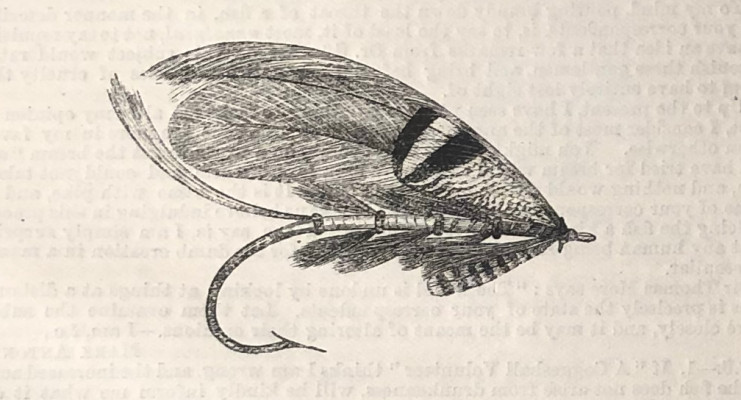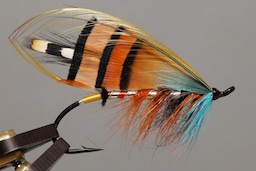From "The fishing gazette" - November 29nd, 1884
Before
proceeding to comment further upon the subject of wings, let us just
look through our list of implements for fly dressing, which revision
perhaps comes better late than not at all.
In the first place,
then, are our old fly-maker's scissors worthy the name? No. Rather an
inelegant and abrupt summing-up that, but the word comes in pat for the
purpose.
"Use is second nature," we know; but let me tell you
that those "old friends," however much we may become accustomed to them,
are nothing like so handy and so appropriate as embroidery scissors.
Yes, with these we are far more accurate; they get where others won't
go, and are directed so much more easitly. Their points should be ground
very fine above and below to admit of our cutting the stump of wings to
what we like - that is, to a perfectly true taper; and, later on, I
will note what we gain in reference to this. Then, to my mind, where do
we see a proper pair of tweezers? The "catch" is always too bulky, not
in width or length, but in thickness, and only bites at the mouth,
especially those made of steel. "Where else should they bite?" it may be
inquired. All along the nipping part, I fancy, which is that space
alluded to as the catch.
Then would the "hold on"; "rotten
hackles" be an expression of the past; and we should never be
unpleasantly reminded of a gavourite corn, and find no occasion to
mutter unbecomming adjectives, which some people set down as curses.
The objection may appear slight; I merely desire to notice the disadvantage.
The
remedy is to untrim them, for the spring to lose its control, and when
so opened, to file the jaws thinner; but the brass sort can be bent and
regulated with a pair of pliers, to shut truly, and need no filing at
all.
The vice quesion, I am told, has been ventilated in the
GAZETTE. I did not see the controversy; at any rate (speaking of myself
again, which I always seem to be doing), I cannot work precisely with a
vice, and so never use mine, even for the smallest trout flies. Of
course professionals do, because they can progress more rapidly; but
whether in such diminutive flies they work is up to our standard is
enitrely another quesion. That it is very servicable to dressers who
work elaborate bodies of salmon flies from the head end of the hook
there can be no two opinions.
Of the stiletto I have spoken
previously. The ordinary bull-necked stumpy sort are still to be seen
with mother-o'-pearl handles in "ladies' companions," but they are not
so suited to us as those sold by Wilcox and Gibbs, which, in dimension,
shape, and temper, exactly answer every purpose. To use an ordinary
needle for picking out bodies is unquestionably a dangerous business -
it penetrates too easily, and it frequently detaches and liberates fur
spun round and round the tying silk, and consequently loosens the tinsel
forming the ribs.
The strokes of our stiletto should be pretty
much after that of an artist's pen in shading, and should begin at the
head end of the fly, the operation being directed towards the barb of
the hook. The light and rapid movements "draw down" rather than "pick
out" the accumulation, which should incline, as nearly as possible, in
the line of march, as the fibres of the hackle. But it may be observed
that the performance is not to be thought of until the fly is completed;
in fact, it is the finishing touch.
And let me repeat how very
usefly this little article is from the beginning to the end of the work,
and how frequently it is put into requisition when we are fishing.
Neither
should we be without spirits of wine, for the least touch of floss silk
bodies with a dampp hand soils them. With that, or even a little eau de
cologne, to moisten the corner of a towel to clean the fingers, and one
will be more at home with a somewhat ungovernable inconvenience; but
when the sumptom returnes, which is sure to happen at the most delicate
moment, drop the work and use the towel again.
The next item can
be ticked off, I hope, without hesitation; however, in my estimation,
cobbler's wax is the best of all. We should only use it when fresh; it
is apt to deteriorate, and it loses much of its consistency when
dissolved, which, in no single instance, is desirable for fly work.
Nor will the next item detain us long. Flies we must have, and we cannot get them too fine or too sharp.
And
now what about our feathers? How important it is - let me say in
preface - to collect them at the proper season of the year. I cannot
hold to the cruel and unnecessary practice of plucking birds, neither
need we torture them, although it is an absolute advantage to robe them
of their winter jckets. A little extra protection from the piercing
winter winds may be easily provided in the fowl house after any free use
of the scissors; but really the few feathers or hackels we generally
take are never missed at all. I have seen necks of roosters, grisly,
shrivelled up, and otherwise spoilt from constant pulling, so much so
that the birds are only fit for breeding purposes - nothing more.
Coch-y-bonddus
and Knee-caps are the most useful natural hackels, and the most
diffifult to find. I believe Farlow and Co. are the only people in this
country who can provide the true knee-cap; some day, I think, we shall
hear a good deal more of this valuable eather.
Perhaps there are
no necks that change so much between winter and summer months as "blue
duns"; the best time to be after them is at Christmas, when the birds
have quite recovered from moulting. I can only call to mind teal and
golden pheasants as exceptions. The latter completes its annual and new
outfit here long before other birds show signs of casting off their
seedy summer garb and we never see a really good speckled teal feahter
till the middle or end of February.
Another most useful bird to
all fishermen is the mallard - the brown mottled flank feather. But I
had better leave that now, and refer to our illustration, as "time
flies"! So it does, fast - very fast; it stirdes on - it weaves on, yet
is it ever new, and, but for that simple reason, it would remind one of
the barque that never sets an anchor - rolling forward, ever on its way.
And
now, what of Miss Evangeline? Whether she be "Miss" or "Mrs." heaven
only knows. At least, arrayed in all her charms, she is very "taking"
young lady. If she has not "taken" - as a fisherman says - it may be
that she has never been tried;
"But, if in nupital union she should last,
'Twill be th' Goss'mer silk' that holds her fast."
That
she, however, will unite to angling society, and be always confined to
perpetual admiration, is, in my opinion, beyond the shadow of doubt.
it
may be assumed, from my initmation, then, that Evangeline is "fresh
from non-existence"; in other words, the anniversary of her first
birthday in the ordinary course of things will take place in 1885, and
therefore I may be excused from jumping at further conclusions of her
inherent capability. But that she will not be destitute of friends in
the opening of the season is my firm and sure conviction.
There
is, perhaps, no living fisherman who has more faith in a fly than
myself; yet I can but reflect - even with all these beautiful and modern
specimens - that could we dive deeper into the vast ocean of Thought
our reward would be the discovery of numberless resources, which are
waiting for us, and as yet undreamt of "in our" (piscatorial)
"philosophy." There, and there only, could we permeate our work with any
close and loving observation of nature.
Foresight, we do know,
as well as firmenss, proves a successful combination to the salmon
angler; then let us take special care of our stock of flies just now;
let us put plenty of napthaline crystal in our packets, and let them be
put away in coy recesses now - now while winter's gathering dirge comes
whispering in.
Evangeline may be described as follows:-
Tag: Silver twist and golden topping coloured silk.
Tail: Topping.
Butt: Black herl.
Body:
In four equal divisions - the first two of silver tinsel, butted as
before, with two blue chatterer feathers (in each) top and bottom, as
illustrated; the third and fourth, floss silk and butted, the former
being the colour of the "tips" of the four red crow's feathers, which
are placed as shown, the other red claret silk, the crows being
repeated. Both of thse sections are:
Ribbed: Silver tinsel.
Throat: Two jay's - one on either side.
Wings: Two yellow feathers from the blue macaw.
Cheeks: Summer duck, with golden topping over.
Horns: Red macaw.
Head: Black herl.
N.B. - It should always be understood, when reading "the sections are butted," that the head "butts" the final one.
|

